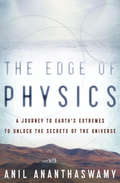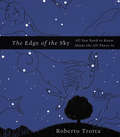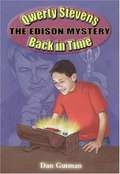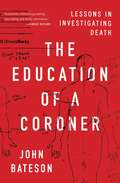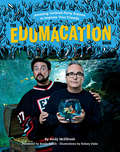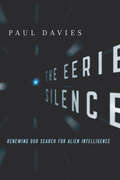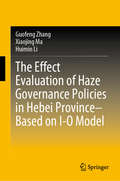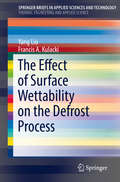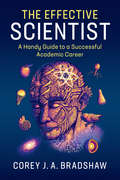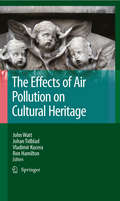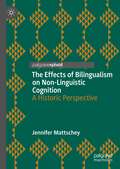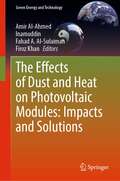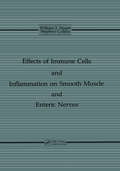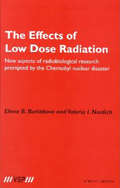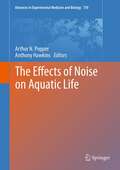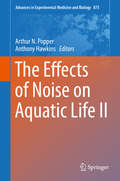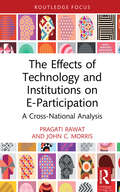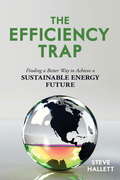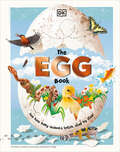- Table View
- List View
The Edge of Physics: A Journey to Earth's Extremes to Unlock the Secrets of the Universe
by Anil AnanthaswamyA tour of the exotic and remote outposts where scientists seek answers to the great mysteries: &“A thrilling ride around the globe and around the cosmos.&” —Sean Carroll, author of From Eternity to Here In The Edge of Physics, a science writer journeys to the ends of the Earth—visiting remote and sometimes dangerous places—in search of the telescopes and detectors that promise to answer the biggest questions in modern cosmology. Anil Ananthaswamy treks to the Atacama Desert in the Chilean Andes, one of the coldest, driest places on the planet, where not even a blade of grass can survive, and the spectacularly clear skies and dry atmosphere allow astronomers to gather brilliant images of galaxies billions of light-years away. He takes us inside the European Organisation for Astronomical Research in the Southern Hemisphere&’s Very Large Telescope on Mount Paranal, where four massive domes open to the sky each night &“like a dragon waking up.&” Ananthaswamy also heads deep inside an abandoned iron mine in Minnesota—where half-mile-thick rock shields physicists as they hunt for elusive dark matter particles. And to the East Antarctic Ice Sheet, where engineers are drilling 1.5 miles into the clearest ice on the planet. They are building the world&’s largest neutrino detector, which could finally help reconcile quantum physics with Einstein&’s theory of general relativity. The stories of the people who work at these and other research sites make for a compelling new portrait of the universe—and our quest to understand it. &“From the top of Hawaii&’s Mauna Kea to Switzerland&’s Large Hadron Collider and more, Ananthaswamy paints a vivid picture of scientific investigations in harsh working conditions. . . . Even for readers who don&’t know a neutrino from Adam, these interesting tales of human endeavor make The Edge of Physics a trip worth taking.&” —Bookpage &“Ananthaswamy journeys to several geographically and scientifically extreme outposts, and returns not only with engaging portraits of the men and women who work there, but also a vibrant glimpse of how cutting-edge research is actually performed. Part history lesson, part travelogue, part adventure story, &‘The Edge of Physics&’ is a wonder-steeped page-turner.&” —Seed Magazine &“Ananthaswamy displays a writer&’s touch for the fascinating detail.&” —The Washington Post
The Edge of the Sky: All You Need to Know About the All-There-Is
by Roberto TrottaFrom the big bang to black holes, from dark matter to dark energy, from the origins of the universe to its ultimate destiny, The Edge of the Sky tells the story of the most important discoveries and mysteries in modern cosmology#151;with a twist. The book’s lexicon is limited to the thousand most common words in the English language, excluding physics, energy, galaxy, or even universe. Through the eyes of a fictional scientist (Student-People) hunting for dark matter with one of the biggest telescopes (Big-Seers) on Earth (Home-World), cosmologist Roberto Trotta explores the most important ideas about our universe (All-there-is) in language simple enough for anyone to understand. A unique blend of literary experimentation and science popularization, this delightful book is a perfect gift for any aspiring astronomer. The Edge of the Sky tells the story of the universe on a human scale, and the result is out of this world.
The Edison Mystery
by Dan GutmanThirteen-year-old Robert "Qwerty" Stevens uses the time machine he finds in his backyard to visit Thomas Edison's workshop in 1879, and there helps develop the electric light bulb, but then needs his sister's help to return to his own time.
The Education of a Coroner: Lessons in Investigating Death
by John BatesonIn the vein of Dr. Judy Melinek’s Working Stiff, an account of the hair-raising and heartbreaking cases handled by the coroner of Marin County, California throughout his four decades on the job—from high-profile deaths to serial killers, to Golden Gate Bridge suicides.Marin County, California is a study in contradictions. Its natural beauty attracts thousands of visitors every year, yet the county also is home to San Quentin Prison, one of the oldest and largest penitentiaries in the country. Marin ranks in the top one percent of counties nationwide in terms of affluence and overall health, yet it is far above the norm in drug overdoses and alcoholism, and comprises a large percentage of suicides from the Golden Gate Bridge. Ken Holmes worked in the Marin County Coroner’s Office for thirty-six years, starting as a death investigator and ending as the three-term, elected coroner. As he grew into the job—which is different from what is depicted on television—Holmes learned a variety of skills, from finding hidden clues at death scenes, interviewing witnesses effectively, managing bystanders and reporters, preparing testimony for court to notifying families of a death with sensitivity and compassion. He also learned about different kinds of firearms, all types of drugs—prescription and illegal—and about certain unexpected and potentially fatal phenomena such as autoeroticism. Complete with poignant anecdotes, The Education of a Coroner provides a firsthand and fascinating glimpse into the daily life of a public servant whose work is dark and mysterious yet necessary for society to function.
The Education of a Russian Statesman: The Memoirs of Nicholas Karlovich Giers
by Barbara Jelavich Charles JelavichThis title is part of UC Press's Voices Revived program, which commemorates University of California Press’s mission to seek out and cultivate the brightest minds and give them voice, reach, and impact. Drawing on a backlist dating to 1893, Voices Revived makes high-quality, peer-reviewed scholarship accessible once again using print-on-demand technology. This title was originally published in 1962.
The Edumacation Book: Amazing Cocktail-Party Science to Impress Your Friends
by Andy McElfreshBoost your trivia knowledge with the Edumacation podcast&’s co-host and this expedition to the bizarre and extraordinary outskirts of scientific discovery Class is now in session with Professor Andy McElfresh (not a real professor), science aficionado and co-host of the Edumacation podcast with Kevin Smith. This is the book that gives you a crash course in Cocktail-Party Science, the strange and astonishing scientific facts that you&’ll want to share at all your social gatherings. Chapters explore the Four Chambers of Knowledge—The Sci, The Fi, The Why, and The Bye—and examine such tantalizing topics as:• Elevator Decapitations and a Deadly Wedgie• Bigfoot, Mermaids, and the Mongolian Death Worm• Dolphins Getting High Off Puffer Fish Toxin• Staggering Feats of Shaolin Monks• The Pentagon&’s Weaponized Heat Ray• Flying Cars, Real Telepathy, and Other Breakthroughs of Tomorrow and many more! Open this book and open your mind: You&’re about to get Edumacated!&“Edumacation is like peeking into Andy&’s fact-filled brain–each topic is silo-ed into rough categories packed to the brim with historical and scientific information…He litters the book with his funny banter and crunches large topics into more manageable, bite-sized pieces. Overall, this book reads less like a scientific tome and more like a conversation with your best friend. It&’s light, funny and you come out of it feeling good about yourself. You also pick up some neat trivia to share at parties!&”—Nerdophiles
The Eerie Silence: Renewing Our Search for Alien Intelligence
by Paul Davies“Refreshing . . . A penetrating analysis of the assumptions that underlie SETI and the entire enterprise of searching for life beyond Earth.” —Chris McKay, NatureFifty years ago, a young astronomer named Frank Drake first pointed a radio telescope at nearby stars in the hope of picking up a signal from an alien civilization. Thus began one of the boldest scientific projects in history, the Search for Extraterrestrial Intelligence (SETI). After a half-century of scanning the skies, however, astronomers have little to report but an eerie silence—eerie because many scientists are convinced that the universe is teeming with life. Physicist and astrobiologist Paul Davies has been closely involved with SETI for three decades and chairs the SETI Post-Detection Taskgroup, charged with deciding what to do if we’re suddenly confronted with evidence of alien intelligence. He believes the search so far has fallen into an anthropocentric trap—assuming that an alien species will look, think, and behave much like us. In this provocative book Davies refocuses the search, challenging existing ideas of what form an alien intelligence might take, how it might try to communicate with us, and how we should respond if it does.“Paul Davies gives us a panoramic view of the quickening search for cosmic company—a fascinating tale stuffed with novel ideas about the nature of intelligence far beyond our own.” —Seth Shostak, Senior Astronomer, SETI Institute“An immensely readable investigation of the SETI enterprise . . . [A] wonderful book.” —New Scientist“A far-ranging look at what might happen here on Earth when we make first contact. Highly recommended for both science fiction and astronomy buffs.” —Publishers Weekly
The Effect Evaluation of Haze Governance Policies in Hebei Province–Based on I-O Model
by Guofeng Zhang Xiaojing Ma Huimin LiThis book provides a dynamic simulation model based on input-output table. The model includes an objective function, i.e. maximizing economic and social development and three sub-models, including economic growth model, pollutant emission model and energy balance model. The data of 2012 is selected as the base period data. The haze control policy of Hebei Province is written into the model as an exogenous variable. Reducing the total PM2.5 emissions is an environmental constraint, which is used to eliminate the impact of natural factors on environmental quality. Lingo software is used to simulate this model. By comparing the socio-economic impacts in different scenarios, this book found the most effective policy combination of haze governance. Comprehensive haze governance policy recommendations provide experience for other regions of China and other developing countries. In this book, the dynamic simulation model of haze governance also provides a reference to other environmental policy simulations.This book is divided into five parts. The first part is an introduction. This paper mainly introduces the research background, research status at home and abroad, the purpose and significance of the study, the content and methods of the study, the key scientific problems to be solved and the expected results. In the second part, the current situation and existing problems of economic, social, energy and environment development in the study area are analyzed in detail. In the third part, a comprehensive evaluation model of dynamic optimization of haze control policy is constructed. The fourth part carries on the simulation experiment, and carries on the analysis to the experimental result. The fifth part puts forward the policy suggestions to realize the economic, social, energy and environmental development of Hebei Province.In this book, we have some understandings about haze governance. From the perspective of policy effect, the policy effects of subsidy for soil and water conservation, subsidy for development and utilization of clean energy, subsidy for new energy vehicles, motor vehicle restriction and subsidy for introduction of PM2.5 treatment technology are decreasing. Comprehensive policy can better achieve the goal of sustainable development of economy, energy and environment than single policy, and the effect of "source governance" policy is better than that of "end governance" policy.
The Effect of Hydrogen and Hydrides on the Integrity of Zirconium Alloy Components
by Manfred P. PulsBy drawing together the current theoretical and experimental understanding of the phenomena of delayed hydride cracking (DHC) in zirconium alloys, The Effect of Hydrogen and Hydrides on the Integrity of Zirconium Alloy Components: Delayed Hydride Cracking provides a detailed explanation focusing on the properties of hydrogen and hydrides in these alloys. Whilst the emphasis lies on zirconium alloys, the combination of both the empirical and mechanistic approaches creates a solid understanding that can also be applied to other hydride forming metals. This up-to-date reference focuses on documented research surrounding DHC, including current methodologies for design and assessment of the results of periodic in-service inspections of pressure tubes in nuclear reactors. Emphasis is placed on showing how our understanding of DHC is supported by progress in general understanding of such broad fields as the study of hysteresis associated with first order phase transformations, phase relationships in coherent crystalline metallic solids, the physics of point and line defects, diffusion of substitutional and interstitial atoms in crystalline solids, and continuum fracture and solid mechanics. Furthermore, an account of current methodologies is given illustrating how such understanding of hydrogen, hydrides and DHC in zirconium alloys underpins these methodologies for assessments of real life cases in the Canadian nuclear industry. The all-encompassing approach makes The Effect of Hydrogen and Hydrides on the Integrity of Zirconium Alloy Component: Delayed Hydride Cracking an ideal reference source for students, researchers and industry professionals alike.
The Effect of Surface Wettability on the Defrost Process (SpringerBriefs in Applied Sciences and Technology)
by Francis A. Kulacki Yang LiuThis SpringerBrief presents a recent advancement in modeling and measurement of the effect of surface wettability on the defrost process. Carefully controlled laboratory measurements of the defrosting of cooled surfaces are used to reveal the effect of surface wetting properties on the extent and speed of frost removal by melting or slumping. The experiments are accompanied by visualization of frost removal at several defrosting conditions. Analysis breaks the defrost process into three stages according to the behavior of the meltwater. Surface wetting factors are included, and become significant when sufficient meltwater accumulates between the saturated frost layer and the surface. The book is aimed at researchers, practicing engineers and graduate students.
The Effective Scientist: A Handy Guide to a Successful Academic Career
by Corey J. A. BradshawWhat is an effective scientist? One who is successful by quantifiable standards, with many publications, citations, and students supervised? Yes, but there is much more. Truly effective scientists need to have influence beyond academia, usefully applying and marketing their research to non-scientists.<P><P> This book therefore takes an all-encompassing approach to improving the scientist's career. It begins by focusing on writing and publishing – a scientist's most important weapon in the academic arsenal. Part II covers the numerical and financial aspects of being an effective scientist, and Part III focuses on running a lab effectively. The book concludes discussing the more entertaining and philosophical aspects of being an effective scientist. Little of this material is taught in university, but developing these skills is vital to maximise the chance of being effective. Written by a scientist for scientists, this practical and entertaining book is a must-read for every early career-scientist, regardless of specialty.
The Effects of Air Pollution on Cultural Heritage
by Ron Hamilton John Watt Johan Tidblad Vladimir KuceraThis book reviews the sources of the air pollutants responsible for building damage and the mechanisms involved. Studies investigating the relationships between pollution concentration (dose) and the resulting damage (response) are described and the latest research findings for dose-response functions are presented. Trends in pollutant emissions, ambient concentrations and building damage over time are described and future predictions are presented. Methodologies for assessing the extent of the potential problem in a region - the stock at risk - are presented. Procedures for estimating the economic implications are described and the consequences are discussed in detail, because economic factors are important for reaching policy and management decisions at local, national and international scales. Damage to cultural heritage buildings is an important additional effect which needs to be considered as the standards are revised and the factors which will need to be brought into the assessment are presented.
The Effects of Bilingualism on Non-Linguistic Cognition: A Historic Perspective
by Jennifer MattscheyThis book examines a century of research on the relationship between bilingualism and intelligence and relates it to more recent research on bilingualism and executive functioning. In doing so, it highlights how bilingualism research has been understood and used by wider society and its impact on current debates in cognitive science as well as language policy and education. The book probes the correlation between the fact that while early intelligence research suggested a negative effect of bilingualism on intelligence, the so-called “Bilingual Problem”, later research implied a positive effect, “the Bilingual Advantage.” It questions whether the negative consequences that arose from the Bilingual Problem are influencing researchers’ reluctance to let go of the Bilingual Advantage. Findings on both the bilingual ‘advantage’ and ‘disadvantage’ are shown to have suffered from similar methodological problems, with research into the former finding itself at the centre of the ongoing replication crisis in psychology. This book provides fresh insights that will be of particular interest to students and scholars of cognitive psychology, psycholinguistics, bilingualism, applied linguistics, education and the history of science.
The Effects of Dust and Heat on Photovoltaic Modules: Impacts and Solutions (Green Energy and Technology)
by Inamuddin Firoz Khan Amir Al-Ahmed Fahad A. Al-SulaimanThis book discusses how to reduce the impact of dust and heat on photovoltaic systems. It presents the problems caused by both dust accumulation and heat on PV systems, as well as the solutions, in a collected piece of literature. The Effects of Dust and Heat on Photovoltaic Modules: Impacts and Solutions begins by discussing the properties of dust accumulation on PV modules. It then presents several solutions to this, such as hydrophobic coatings and surface texturing. The second half of the book is used to discuss the effects of heat on silicon PV modules, as well as various cooling approaches. These include water cooling and carbon-based materials. Due to the prevalence of PV systems in renewable energy, this book will be of interest to numerous students, researchers and practitioners.
The Effects of Economic News on Commodity Prices: Is Gold Just Another Commodity?
by Shaun K. Roache Marco RossiA report from the International Monetary Fund.
The Effects of Immune Cells and Inflammation On Smooth Muscle and Enteric Nerves
by Jr. Snape Stephen M. CollinsThis book provides the first comprehensive review of research that addresses the immunomodulation of gastrointestinal motility. Results from this new field of research are important for understanding motility disturbances and symptom-generation in a variety of clinical gastroenterological problems, including ulcerative colitis, Crohn's disease, enteric infections, and food allergies. The book provides overviews on current perspectives regarding the nature of inflammatory processes, inflammatory mediators, and other immune factors. It also describes a variety of experimental approaches that have been used to study the interactions between immune cells and smooth muscle or enteric nerves. The approaches include in vivo, as well as in vitro studies. Researchers involved in the general field of immunophysiology, as well as the more specific fields of gastrointestinal motility and inflammatory bowel diseases will find this book to be invaluable in their research.
The Effects of Low Dose Radiation: New aspects of radiobiological research prompted by the Chernobyl nuclear disaster
by Elena Burlakova Valeria NaiditchThe papers collected in this book show the results of investigations performed by Russian scientists in the field of low dose irradiation action. It is confirmed that low doses do have effects on the human organism and the environment and that the most serious consequences are observed in the far post-irradiation period. This branch of radiobiology
The Effects of Noise on Aquatic Life
by Arthur N. Popper Anthony HawkinsThe Second International Conference on the Effects of Noise on Aquatic Life will take place in Ireland August 15-20, 2010. The main emphasis of the conference will be on defining the current state of knowledge. However, we will also assess progress in the three years since the First conference. The Second conference will place strong emphasis on recent research results, the sharing of ideas, discussion of experimental approaches, and analysis of regulatory issues.
The Effects of Noise on Aquatic Life II
by Arthur N. Popper Anthony HawkinsThe meeting of Aquatic Noise 2013 will introduce participants to the most recent research data, regulatory issues and thinking about effects of man-made noise and will foster critical cross-disciplinary discussion between the participants. Emphasis will be on the cross-fertilization of ideas and findings across species and noise sources. As with its predecessor, The Effects of Noise on Aquatic Life: 3rd International Conference will encourage discussion of the impact of underwater sound, its regulation and mitigation of its effects. With over 100 contributions from leading researchers, a wide range of sources of underwater sound will be considered.
The Effects of Noise on Aquatic Life: Principles and Practical Considerations
by Arthur N. Popper Anthony D. Hawkins Joseph A. Sisneros Frank ThomsenIn this landmark new work, the major authorities in the field from around the world present a wealth of research data, coverage of regulatory issues, and thinking about the effects of man-made noise on marine mammals, turtles, amphibians, fishes, and invertebrates. The various themes of the book were chosen to cover the wide range of basic and cutting edge information on this topic. They include the hearing abilities of aquatic animals; communication by means of underwater sound; the description of aquatic soundscapes; different sound sources and their characteristics; the effects of sound on behavior; and assessing, mitigating, and monitoring the effects of aquatic noise. Emphasis is on the cross-fertilization of ideas and findings across species and noise sources. With over 140 contributions from leading researchers, the sources of underwater sound and their effects are discussed in detail.
The Effects of Technology and Institutions on E-Participation: A Cross-National Analysis (Routledge Research in Public Administration and Public Policy)
by John C. Morris Pragati RawatIn this book Pragati Rawat and John C. Morris identify and evaluate the impact of factors that can help explain the difference in e-participation, public participation using information and communication technology, in different countries. While cross-sectional studies have been covered, few have taken an in-depth look at cross-national studies. This book attempts to fill the gap using quantitative panel data to explore the influence of technology and institutions, and the impact of their complex relationships in a mediation and moderation analysis, on e-participation. The current study reviews the scholarly work in the field of “offline” and “online participation” to identify a set of antecedents that influence e-participation. A conceptual framework is developed, supported by the theories from the public policy and socio-technical premise. The authors utilize secondary data, primarily from the UN and World Economic Forum, for 143 countries from three waves of surveys to measure the dependent and explanatory variables. The panel data is statistically analyzed and findings reveal the role of technology as a mediator as well as a moderator for institutions’ impact on e-participation. The Effects of Technology and Institutions on E-Participation provides a groundbreaking country-level analysis that will appeal to academics and students of e-government and Digital Government, Public Policy, Public Administration, Public Sector Innovation, and Public Participation.
The Efficiency Trap
by Steve HallettThis realistic appraisal of current environmental thinking will challenge environmentalists and industrialists alike. One of the key tenets of the environmental movement is the need for greater efficiency in our use of dwindling natural resources, especially coal, natural gas, and oil. If our products are designed to be more energy efficient, so the thinking goes, our environmental impacts will be reduced and our fossil fuels will last longer. In this surprising new look at sustainability and conservation, environmentalist Steve Hallett argues that this thinking is fundamentally flawed. In fact, based on the example of coal use throughout the Industrial Revolution, more efficiency leads to more consumption, faster depletion of resources, and ultimately more stress on the planet. This is the efficiency trap. How do we avoid this trap? Hallett suggests that we focus on protecting natural resources, ecosystems, and social systems by making them more resilient. Knowing that we have reached limits to growth, we should work to decentralize energy-delivery services to give homes and communities some measure of independence. We can also build more sustainable food systems by diversifying the food-production landscape to address the vulnerabilities of the current supply chain. Efficiency does have its place in specific areas such as recycling and home insulation, but it will not work as a long-term approach to our energy dilemma. Yet recognizing the inevitable limits to our growth and the shortcomings of our current approach to addressing our dwindling resources is a necessary first step toward the establishment of sound environmental policy.
The Egg Book: See How Baby Animals Hatch, Step By Step!
by DKLearn about the remarkable beginnings of life with this adorable book of baby animals hatching from their eggs.Find out all about how eggs hatch step by step in this fascinating baby animal book for children. Many animals start life inside eggs and this book explores these magical capsules in detail, with stunning photographs of the moment the creatures emerge.Featuring more than 20 animals – including a penguin, a tortoise, and even a slug – this book documents the moment of hatching in detail. Children aged 5-7 can learn how birds, reptiles, amphibians, fish, and invertebrates hatch from their eggs, as well as what happens inside an egg&’s shell.This captivating animal book for children features: - A step-by-step account of different types of animals hatching, as well as what an egg is, which animals have eggs, and what is inside an egg.- Introductory pages that explain which animals have eggs and how they work.- Large, detailed photographs show eggs hatching almost in real-time.- A wide range of animals, from birds to amphibians and insects.With expert information, jaw-dropping photography, and a beautifully shiny foil finish, The Egg Book is the ideal gift for any child with a love of nature and baby animals. Children will love to see the biggest egg in the world hatching, find out which animals have jellylike eggs, and which animals&’ egg cases are known as &“mermaids&’ purses&”.
The Eggplant Genome (Compendium of Plant Genomes)
by Mark A. ChapmanThe book discusses the importance of eggplant (Solanum melongena L.) as a crop, highlighting the potential for eggplant to serve as a model for understanding several evolutionary and taxonomic questions. It also explores the genomic make-up, in particular in comparison to other Solanaceous crops, and examines the parallels between eggplant and tomato domestication as well as between the most common eggplant species and two related eggplants native to Africa (Ethiopian eggplant [Solanum aethiopicum L.] and African eggplant [Solanum macrocarpon L.]).The eggplant genome was first sequenced in 2014, and an improved version was due to be released in 2017. Further investigations have revealed the relationships between wild species, domesticated eggplant, and feral weedy eggplant (derived from the domesticate), as well as targets of selection during domestication. Parallels between eggplant and tomato domestication loci are well known and the molecular basis is currently being investigated.Eggplant is a source of nutrition for millions of people worldwide, especially in Southeast Asia where it is a staple food source. Domesticated in the old world, in contrast to its congeners tomato and potato, the eggplant is morphologically and nutritionally diverse. The spread of wild eggplants from Africa is particularly interesting from a cultural point of view. This book brings together diverse fields of research, from bioinformatics to taxonomy to nutrition to allow readers to fully understand eggplant’s importance and potential.
